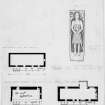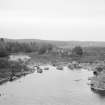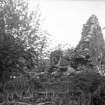Pricing Change
New pricing for orders of material from this site will come into place shortly. Charges for supply of digital images, digitisation on demand, prints and licensing will be altered.
Field Visit
Date 28 May 1921 - 25 March 1926
Event ID 932988
Category Recording
Type Field Visit
Permalink http://canmore.org.uk/event/932988
Church and Teampull, Skeabost Island.
The island in the River Snizort, about 100 yards below Skeabost Bridge and about ¼ mile above its mouth, some 5½ miles north-west of Portree, is occupied by a churchyard containing the ruins of two churches, one of comparatively late date and the other, the Teampull, smaller and much earlier.
CHURCH. This building, which stands almost east and west and measures externally about 79 feet in length and 26 feet 9 inches in breadth, is now represented by grass-covered mounds rising generally about 2 feet above ground near the centre of the island. It has been encroached on by walled private burying grounds, and the only piece of building visible is on the north side near the eastern end. It would seem to have had a chancel.
FONT. A broken stone font or stoup roughly square in shape, measuring 16 inches in length by 15 inches in breadth and 11 inches in height, with a cavity 10 inches in diameter at the mouth and 8 inches deep, was observed in 1914 lying on the grassy mound of the western wall of the church. It cannot now be found.
TEAMPULL. Towards the west end of the island is the roofless church of St Columba in a fairly good state of preservation, the southern wall being somewhat broken down. It is orientated almost due east and west and measures 15 feet 10 inches in length and 9 feet 4 inches in breadth in the inside, the walls of stone and shell lime being 2 feet 8 inches thick. The northern wall, which is complete, stands 7 feet high; the gables are about 11 feet. Both gables are intaken 5 inches at the wall head, indicating that we have to do with an early medieval not an old Celtic structure. The door, which wants the lintel, is 3 feet wide on the outside, being splayed on either side towards the interior; it is placed 4 feet 7 inches from the north-west corner of the building. There are two windows, both with inward splays. The first, in the centre of the east gable, 2 feet 9 inches from the ground , measures 20 inches in length by 5 inches in breadth externally and 3 feet 5 inches in height and 2 feet 3 inches in breadth internally; and the second, in the south wall, 7 feet 3 inches from the south-east corner, is broken on the western jamb.
The building is mainly of polygonal stones packed with some rectangular and many small stones.
HISTORICAL NOTE. This church bears the name of St Columba. In 1501 'Schir Nichol Berchame' was 'chapellane of the parsonage of Sanct Colmez Kirk in Sneesfurd in Trouternes, in the lordschip of the Islis, togidder with the annexis and vic aragis thairof, that is to say Kilmolowok in Raasy and Kilmory in Walternes (Vaternish)' (1).
The vicarage of Snizort and Raasay ('Sneisport and Rairsay') was received in 1526 by Sir Donald Monro, author of the Description of the Western Isles (1549) (2). In 1561 'the personage of Snisport in Troutirnese' pertained to the Bishop of the Isles (3). The parish of Snizort till 1726 included what was then disjoined to form the parish of Portree.
(1) Reg. Sec. Sig., 1., No. 675.
(2) Orig. Paroch., vol. ii., part i., p. 355.
(3) Collecianea de Rebus Albanici s, p. 4.
MONUMENTAL EFFIGIES, SKEABOST ISLAND.
There are at least three grave slabs in the kirkyard with the figure of a knight carved in relief on their upper face. The best preserved lies to the south-west of the late church. It is of the usual bluish schist and measures 6 feet 7 inches in length, 2 feet in breadth at the top tapering to 1 foot 9 ½ inches at the foot, and about 5 ½ inches in thickness. In a sunk panel following the contour of the figure it bears an armed man with a bascinet, camail of banded mail and quilted coat reaching to the knees. The hands are held at the front, the left grasping a claymore 3 feet 6 inches long with the hilt 7 ¾ inches in length and depressed quillons 3 ¾ inches long. The blade tapers from 2 ½ inches at the quillons to 2 inches at the point. In the dexter top corner the initials MMS RMS IMS are cut in late lettering. These are said to refer to a family named MacSween, who would have used this stone to mark their place of burial (1). In the sinister corner is a small winged figure grasping a spear in his left hand and treading on an animal- St Michael.
Nearby is a slab with a figure in high relief, which is clothed in the usual quilted coat to the knees with a very high pointed bascinet and camail; the right hand clasps the belt, the left rests on the quillon of the sword. This figure is broken at the feet and is much worn by weather. Within the church is another similar figure slab in high relief, which also is broken and badly weathered: in this case there is no quilted coat, while the claymore is grasped at the hilt by the left hand and hangs between the legs.
There is said to be a fourth figured slab, but it could not be found; the churchyard is in the usual island condition of being neglected and thickly overgrown.
(1) Proc. Soc. Ant. Scot., XLIV., p. 374.
RCAHMS 1928, visited by 28 May 1921 and 25 March 1926.
OS map: Skye xxiii.















